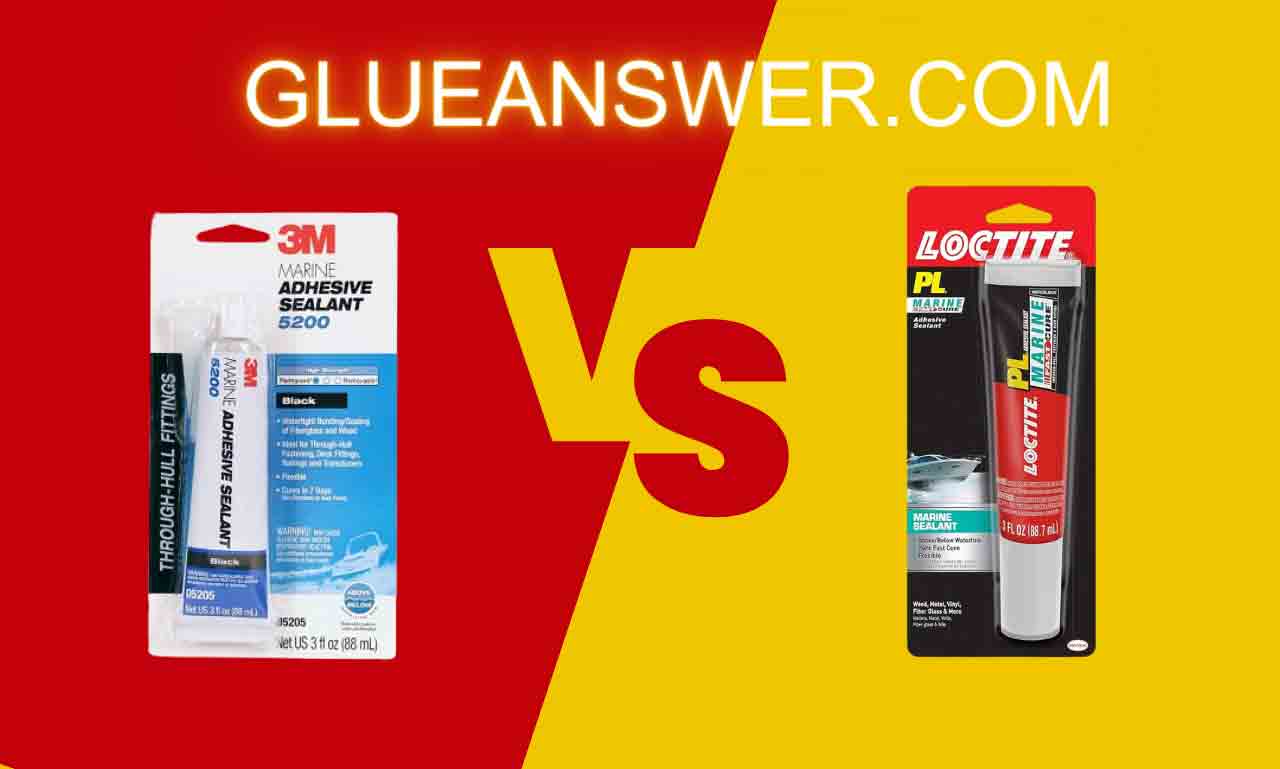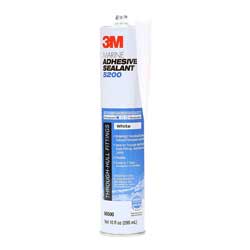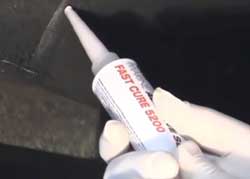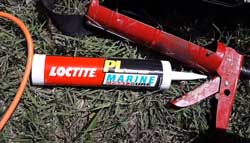Loctite Marine Sealant vs 5200: Marine Showdown

Loctite Marine Sealant vs 5200: The Loctite marine sealant is an adhesive polymer that sticks to almost any surface and creates a watertight barrier against moisture, chemicals, and even radiation in some cases.
Loctite Marine Sealant is formulated to resist harsh conditions, including saltwater exposure, this sealant excels in creating watertight seals around hatches, portholes, and other boat accessories. Its flexibility, coupled with UV resistance, makes it an ideal choice for above-the-waterline applications.
On the other hand, Loctite 3M 5200 is noticeably thinner and prone to running. Designed to create permanent, flexible bonds, it is particularly effective for bonding dissimilar substrates. Its resistance to both saltwater and freshwater, coupled with the ability to withstand dynamic loads, positions it as a go-to choice for below-the-waterline applications, such as hull seams and through-hull fittings.
Loctite Marine Sealant:
Best for:
- General purpose sealing: Hatches, windows, deck hardware, non-structural applications.
- Fast curing: Sets quickly in 2-4 hours, allowing for quicker completion of projects.
- Easy application: Smooth consistency and convenient cartridge packaging make it user-friendly.
- Variety of formulas: Available in various types like polyurethane, silicone, and polysulfide, each with specific properties to cater to different needs.
Features:
- Strong adhesion: Bonds well to various boat materials like fiberglass, wood, and metal.
- Waterproof and salt-resistant: Withstands harsh marine conditions.
- Flexible: Maintains elasticity to accommodate boat movement.
- UV-resistant: Doesn’t degrade under sun exposure.
- Paintable: Can be painted over for aesthetic purposes.
Pros:
- Versatile and suitable for a wide range of marine applications.
- Fast curing for efficient work.
- Easy to use, good for DIY projects.
- Various formulas offer flexibility for specific needs.
Cons:
- May not be as strong or durable as 3M 5200 for high-stress applications.
- Some formulas might not be as resistant to harsh solvents or fuels.
- Not typically recommended for underwater repairs.
3M 5200:
Best for:
- High-stress and structural applications: Bedding deck hardware, sealing through-hulls, bonding wood to fiberglass.
- Superior strength and durability: Creates incredibly strong, long-lasting bonds.
- Fuel and solvent resistance: Can withstand exposure to harsh chemicals.
- Underwater repairs: Formulated for applications below the waterline.
Features:
- Incredible adhesion: Forms super strong bonds to numerous materials.
- Exceptional waterproofness: Remains watertight even in submerged conditions.
- Fuel and solvent resistant: Withstands exposure to harsh chemicals.
- Flexible: Maintains elasticity despite strong bond.
- UV-resistant: Doesn’t degrade under sun exposure.
Pros:
- Unmatched strength and durability for critical applications.
- Can withstand harsh chemicals and underwater conditions.
- Ideal for bedding and structural bonding.
Cons:
- Slower curing: Takes 24-48 hours to fully set, requiring longer project timelines.
- Thick consistency: Can be more challenging to apply compared to Loctite Marine Sealant.
- Limited variety of formulas: Primarily comes in polyurethane, not offering the same customization as Loctite.
Ultimately, the best choice depends on your specific needs:
- For general sealing and quick projects, Loctite Marine Sealant offers versatility and ease of use.
- For high-stress applications, underwater repairs, or where the strongest bond is required, 3M 5200 is the go-to choice for its unmatched strength and durability.
Loctite Marine Sealant vs 5200 Comparative Analysis:
- Flexibility and Strength:
- Loctite Marine Sealant offers flexibility, ensuring it can absorb shock and vibrations. It provides a reliable seal but may not be as rigid as 5200.
- Loctite 5200 excels in strength and permanence. Its adhesive properties make it suitable for applications where a robust bond is crucial.
- Versatility:
- Marine Sealant is versatile for above-the-waterline applications, offering resistance to UV rays and weathering.
- Loctite 5200’s versatility extends below the waterline, making it suitable for projects demanding a strong, permanent bond in constantly wet conditions.
- Curing Time:
- Both sealants have varying curing times. Marine Sealant generally cures faster, making it convenient for projects with time constraints.
- 5200 may require a longer curing time but compensates with a robust, long-lasting bond.
Here is the difference between Loctite marine sealant vs 5200:
| Loctite marine sealant | 5200 3m sealant |
| Thicker than 5200 3m | Thinner than marine sealant |
| Resist to running | Prone to running |
| Loctite marine sealant is made to withstand acids, alkalis, solvents, etc. | 5200 is made to resist extreme heat and temperature |
| The Loctite marine sealant will work on almost any surface | M 5200 Epoxy Sealant is a two-part epoxy adhesive for bonding metals, plastics, and composites |
| High bonding strength | The bonding strength is lesser than marine sealant |
| Loctite marine sealant is considered a fast-drying | Slow drying |
| Its viscosity for long-term use | Its viscosity for short-term use |
5200 3M Sealant
5200 Sealant is a high-performance sealer designed for the protection of metal, wood, and concrete surfaces in all industrial applications. This product is packaged as an aerosol spray or tube as well as in caulks to be used by hand. The two major varieties of this sealant are 5200 Construction Adhesive and 5200 Clear Sealant. The sealant is made for application on metal, wood, and concrete surfaces.
The Sealant is sprayed from a tube or aerosol can, often in colors according to the type of surface being sealed. It is not recommended that you allow children to spray or inhale this product.
3M Marine Adhesive Sealant 5200

3M Marine Adhesive Sealant 5200 is a durable, high-performance, 3M™ adhesive sealant formulated for permanently bonding fiberglass and acrylic surfaces in the marine environment. This formula combines two raw materials: methyl methacrylate (MMA) as the toughened so it resists water intrusion and thixotropic polyurethane resin (PU) to provide a strong permanent bond that withstands extreme weather conditions.
Features
- Bonds permanently
- High performance
- Stays flexible
- Imparts no odor
- Long lasting adhesion
- Color Stability
Pros
- Durable
- Strong
- Easy to Use
Cons
- Slow-curing (24 hours)
What is 3M 5200 Equivalent?
3M 4200 is a high-performance conformal sealant for use on virtually any hard, non-porous surface. This product is a two-part, fast-curing formula designed to seal and protect non-exposed surfaces within 10 minutes. Available in 1-liter and 2-liter cans. How does 3M 5200 work?
3M 4200 is an ether-based formula with a fast-curing polymer system that reaches high levels of adhesive strength directly from the nozzle and penetrates into hard surfaces to seal and protect them.
You can apply the sealant using a paint sprayer, roller, or brush. The gap-filling consistency acrylic polymer system has good flow characteristics and adheres well to irregular surfaces.
How Strong is Marine 5200?

Marine 5200 is a polysulfide elastomer sealant. It is an automotive, marine, and industrial rubber-based sealant product that resists discoloration and decay in wet environments.
It does not form polymers or gels with water like silicone sealants, which makes it easier to use for various applications. Marine 5200 has good stability in the presence of acids such as nitric, acetic, and hydrochloric acid. 700 pounds_per_square_inch (psi) of pressure is sufficient to hold Marine 5200 in place.
What is 3M 5200 used for?
3M 5200 is one of the most versatile and highest-quality sealants in the industry, with many uses. It has found success in industrial applications and marine environments. Marine 5200 is frequently used to seal electrical wiring and components from water and moisture, UV damage, and corrosion.
Marine 5200 is the go-to sealant for electrical components such as wiring, battery, and junction boxes. It can be used to seal alligator clips, bullet connectors, [ram styles], and multiple screw and riveted terminals. It is also excellent at protecting wind-generator wiring and components from water ingress.
Does 5200 Bond To Aluminum?
No, 5200 is a sealant rather than an adhesive. Only an adhesive will bond to aluminum. If you are looking for a sealant that can adhere to aluminum, consider using these products: Acrylic-based sealants (e.g., Dap Weldwood), silicones (e.g., Silicone Corporation of America, Dow Corning 3-36), or allometric sealants (e.g., Sikaflex).
How Long Does 3M 5200 Take To Cure?
This depends on the depth of the application and the environmental conditions. The cure rate varies with temperature and relative humidity (higher temperatures and lower humidities result in faster cures). Most sealants are fully cured after 48 hours at a temperature of 70 degrees Fahrenheit. Because of their volatility, thinner formulations may cure faster than thicker formulations.
Will 3M 5200 Stick To Metal?
Yes, but only if the metal meets specific quality criteria. The simplest rule is that the metal must be free of corrosive chemicals and not be covered with a protective film (e.g., paint or lacquer). To meet the second criterion, you must clean the metal surface by removing all oily and greasy coatings. When cleaning, don’t overclean! Scrubbing will remove some of the sealants.
What is 3M 5200 Comparable?
3M 5200 is comparable to 3M 4200 Fast, a sealant that cures intermediate resistance. 3M 5200 is comparable to Loctite 454/755, a sealant that cures high resistance. Loctite 454 will cure underwater while 3M 5200 will not.
Flash should dry in 15 minutes at 70 F, 150 minutes at 60 F, and several hours at 50 F. If you are using this product on a boat, you will want to be sure it is fully cured before subjecting it to water because the moisture in rain or spray may weaken the sealant if it is not cured.
Loctite 2016891-12 PL Adhesive Sealant

Ultra-high performance one-part polyurethane adhesive sealant for all boat, pontoon, and houseboat construction, remodeling, and repair. Provides permanent bonding of fiberglass, aluminum, steel, or PVC to any surface including wood. Use as a sacrificial membrane when installing non-watertight materials. For exterior use only; not for structural purposes.
Features
- Dries clear
- Long-lasting adhesion
- Heavy-duty construction
- Easily applied to porous surfaces
- Waterproof, durable, and economical alternative to urethane caulks.
What is Loctite pl Sealant?
Loctite is a chemical sealant used to repair leaks in various pipes and hoses, especially metal fittings. It is a slow-drying liquid that expands, which causes the rubber gasket to heat up and eventually set. This will make it more difficult for sewer gases to enter your home. The EPA has tested the chemicals for indoor and outdoor applications, so you can rest easy knowing you are using an environmentally friendly product.
Uses And Application Area
As a home remedy, you can use it to seal small gaps and cracks in walls, doors, floors, and around fixtures. You can also use it to attach wood trim or cabinets that are bowing or pulling away from the walls. It is also helpful for keeping birds out of chimneys and vents.
When you have a leaky pipe or hose, replacing the entire part may not be cost-effective.
Is Loctite Marine Adhesive Sealant Clear?
Though Loctite is clear when first applied, it darkens and becomes opaque after several hours. This happens because the sealant is not entirely cured before installing the gasket. Loctite marine sealant won’t affect the color of the water, which is why it doesn’t have to be painted or dyed.
Can Loctite Marine Sealant Be Applied Underwater?
Yes, Loctite marine sealant is a water-based sealant that does not have to be painted or dyed. Though it is much broader for marine use, you can still apply it underwater. You can also paint over the exposed part of the pipe before sealing it, though this requires more preparation.
Is Loctite Marine Sealant Permanent?

Loctite marine sealant is a sealant that, by definition, is specific to the marine environment. It will form a permanent seal underwater, degrade over time and eventually fade away. This means that it is not permanent because you may be able to use it again if you don’t expose it to water for too long.
How Long Does Loctite Marine Take To Dry?
Loctite marine sealant will take 24 hours to cure fully. If you force it to dry quickly, it can be damaged during the curing process. Even if the tube is not filled with any sealant, curing is still recommended to be effective over long periods.
Benefits And Drawbacks Of Using A Marine Sealant
Though it may be a tape that is made permanent in the marine environment, Loctite marine sealant will form a seal, which means it is effective over an extended period. But since it already forms a seal, there are no benefits like you would get from “regular” sealants that are designed for use on dry pipes.
The only noticeable drawback with Loctite marine sealant is that it will most likely be more difficult to remove than other types of sealants.
Final Word
Loctite marine sealant vs 5200 3m sealant which is the better choice? You may already have a specific project in mind or maybe you just need a recommendation on what kind of sealant to get. If you’re focused on above-the-waterline tasks and prioritize a faster cure time, the Marine Sealant may be the ideal companion. However, for critical below-the-waterline applications demanding a potent, permanent bond, Loctite 5200 emerges as the champion.




![Can Sealant Foam Be Used On Rotten Wood [What You Need to Know]](https://glueanswer.com/wp-content/uploads/2024/01/Can-Sealant-Foam-Be-Used-On-Rotten-Wood-What-You-Need-to-Know-768x432.jpg)
![How To Apply Acoustic Sealant [with Important Safety Considerations]](https://glueanswer.com/wp-content/uploads/2022/10/How-To-Apply-Acoustic-Sealant.jpg)